Meubles peints du XVIIIe siècle
4 participants
LE FORUM DE MARIE-ANTOINETTE :: La France et le Monde au XVIIIe siècle :: Les Arts et l'artisanat au XVIIIe siècle :: Le mobilier du XVIIIe siècle
Page 1 sur 1
 Meubles peints du XVIIIe siècle
Meubles peints du XVIIIe siècle
Voici une production suffisamment rare pour que nous la présentions ici. 
Il s'agit de deux meubles, peu communs donc, qui seront présentés à l'occasion d'une vente aux enchères, organisée par la maison Sotheby's, Paris, le 6 juillet 2017.
Nous présentons cette vente, ici : https://marie-antoinette.forumactif.org/t3118p25-ventes-aux-encheres-2017#99744
 Je cite l'intéressante note de l'expert (extraits) :
Je cite l'intéressante note de l'expert (extraits) :
Paire de meubles d'entre-deux en acajou et sycomore peint, et monture de bronze doré d'époque Louis XVI, l'ébénisterie attribuée à Ferdinand Bury, la décoration attribuée à Jean-Louis Prévost
L'un formant chiffonnier à décor de bouquets fleuris, ouvrant à cinq tiroirs, les montants à pans coupés, la ceinture à décor d'entrelacs sur fond de sycomore teinté vert, reposant sur une plinthe en bois à l'imitation du marbre brèche vert, dessus de marbre blanc veiné gris.

L'autre formant secrétaire ouvrant à un tiroir muni d'une tablette à écrire et quatre petits tiroirs et par deux vantaux découvrant un intérieur plaqué de bois de rose et d'amarante, muni d'un compartiment à volet à lamelles.

Note au catalogue (extraits) :
Le XVIIIe siècle fut constamment à la recherche d’innovation technique et de raffinement esthétique : c’est ainsi que des meubles couverts de laques de Chine, de vernis Martin, de tôles peintes, de plaques de porcelaine ou encore de plumes ( ), furent créés sous les règnes de Louis XV et Louis XVI.
), furent créés sous les règnes de Louis XV et Louis XVI.

Les meubles plaqués de sycomore peint s’inscrivent dans cette tradition, mais leur production fut très limitée dans le temps, de 1770 à 1800 environ.
Outre la paire que nous présentons, un très petit nombre d’exemplaires de ces meubles sont donc parvenus jusqu’à nous :
- une commode estampillée de Joseph Baumhauer (vente Jaime Ortiz-Patiño, Sotheby’s New York, le 20 mai 1992, lot 93)
- un secrétaire attribué à Joseph Baumhauer (Waddesdon Manor) provenant, comme la commode précédente, de l’ancienne collection de Nicolas Beaujon

- un chiffonnier estampillé de Ferdinand Bury et de Jean-Baptiste II Tuart, précédemment dans les collections d’Arnold Seligmann, Jean Davray, Jean Gismondi, Roberto Polo, puis Pierrette Cordier (sa vente à Paris, Sotheby’s, le 16 décembre 2004, lot 173)

- une paire de petits cabinets en suite avec les présents cabinets et provenant également des collections Rothschild, puis Rosebery à Mentmore (vente Sotheby’s, le 18 mai 1977, lot 451)
- une commode demi-lune estampillée de Cosson (ancienne Arnold Seligmann, puis collection Earl of Rosebery, Dalmeny House, Écosse)
- une paire de bas d’armoire, l’un transformé vers 1840 (collection privée parisienne) et son probable pendant également modifié (collection Earl of Rosebery, Dalmeny House, Écosse)
- une paire de consoles réalisée plus tardivement que les précédents exemples, sous le Consulat (Banque de France).
Parmi ces meubles, les deux premiers sont identifiables dans la vente du banquier de la Cour, Nicolas Beaujon, en 1787 : le catalogue de la vente nous apprend également que l’illustre amateur « en avait ordonné la distribution et le goût » et que le peintre chargé de la décoration était Jean-Louis Prévost « le Jeune » (1740-1810).

Portrait de Nicolas Beaujon
Par Louis-Michel Van Loo
La mise en œuvre de tels meubles nécessitait l’implication d’un tiers coordonnant les travaux de l’ébéniste, du peintre, mais aussi les fournitures du bronzier et du marbrier.
Pour l’ensemble Beaujon, ce fut son architecte attitré Etienne-Louis Boullée qui s’en chargea : on conserve un dessin de sa main représentant un projet de commode très similaire (Ecole Nationale Supérieure des Beaux-Arts, Paris).
Celle-ci et le secrétaire furent sans doute exécutées aux environs de 1770, Joseph Baumhauer décédant en 1772.

Il est intéressant de relever que l’un des élèves de Boullée, l’architecte Théodore-Alexandre Brongniart, posséda lui aussi deux paires de bas d’armoire peints sur fond d’érable sycomore, décrites dans le catalogue de sa vente le 22 mars 1792, lots 165 et 166.
En ce qui concerne le chiffonnier doublement estampillé, ainsi que les cabinets de Mentmore, on peut supposer que la mode lancée par Beaujon fut reprise par l’ébéniste et marchand mercier avisé que fut Jean-Baptiste II Tuart : il fit appel à l’ébéniste Ferdinand Bury (après 1774, date de sa réception à la maîtrise) et très certainement aussi à Prévost dont on reconnaît les délicates compositions florales, notamment les guirlandes tournantes.

Il est fort probable que de tels meubles prenaient place dans des lambris décorés dans le même esprit et constituaient ainsi un décor complètement homogène.
L’architecte Le Carpentier fit aménager pour le prince de Condé au Palais Bourbon un boudoir peint par Deleuze en faux bois de rose et carreaux de porcelaine peints de mille bouquets de fleurs imitant la porcelaine de Sèvres : dans l’un des pans coupés, un secrétaire peint également à l’imitation des carreaux s’intégrait parfaitement au décor.

Vue du Palais Bourbon et de l'Hôtel de Lassay côté Seine, vers 1780
Par Compigné
Toujours dans les années 1770, à Paris rue de Varenne, la comtesse d’Orsay disposait d’un boudoir peint par Hugues Taraval dans le tout nouveau style arabesque où une niche abritait un secrétaire à hauteur d’appui, également décoré d’arabesques peintes (musée du Louvre, inv. OA 6523).
Il s'agit de deux meubles, peu communs donc, qui seront présentés à l'occasion d'une vente aux enchères, organisée par la maison Sotheby's, Paris, le 6 juillet 2017.
Nous présentons cette vente, ici : https://marie-antoinette.forumactif.org/t3118p25-ventes-aux-encheres-2017#99744
Paire de meubles d'entre-deux en acajou et sycomore peint, et monture de bronze doré d'époque Louis XVI, l'ébénisterie attribuée à Ferdinand Bury, la décoration attribuée à Jean-Louis Prévost
L'un formant chiffonnier à décor de bouquets fleuris, ouvrant à cinq tiroirs, les montants à pans coupés, la ceinture à décor d'entrelacs sur fond de sycomore teinté vert, reposant sur une plinthe en bois à l'imitation du marbre brèche vert, dessus de marbre blanc veiné gris.

L'autre formant secrétaire ouvrant à un tiroir muni d'une tablette à écrire et quatre petits tiroirs et par deux vantaux découvrant un intérieur plaqué de bois de rose et d'amarante, muni d'un compartiment à volet à lamelles.

Note au catalogue (extraits) :
Le XVIIIe siècle fut constamment à la recherche d’innovation technique et de raffinement esthétique : c’est ainsi que des meubles couverts de laques de Chine, de vernis Martin, de tôles peintes, de plaques de porcelaine ou encore de plumes (

Les meubles plaqués de sycomore peint s’inscrivent dans cette tradition, mais leur production fut très limitée dans le temps, de 1770 à 1800 environ.
Outre la paire que nous présentons, un très petit nombre d’exemplaires de ces meubles sont donc parvenus jusqu’à nous :
- une commode estampillée de Joseph Baumhauer (vente Jaime Ortiz-Patiño, Sotheby’s New York, le 20 mai 1992, lot 93)
- un secrétaire attribué à Joseph Baumhauer (Waddesdon Manor) provenant, comme la commode précédente, de l’ancienne collection de Nicolas Beaujon

- un chiffonnier estampillé de Ferdinand Bury et de Jean-Baptiste II Tuart, précédemment dans les collections d’Arnold Seligmann, Jean Davray, Jean Gismondi, Roberto Polo, puis Pierrette Cordier (sa vente à Paris, Sotheby’s, le 16 décembre 2004, lot 173)

- une paire de petits cabinets en suite avec les présents cabinets et provenant également des collections Rothschild, puis Rosebery à Mentmore (vente Sotheby’s, le 18 mai 1977, lot 451)
- une commode demi-lune estampillée de Cosson (ancienne Arnold Seligmann, puis collection Earl of Rosebery, Dalmeny House, Écosse)
- une paire de bas d’armoire, l’un transformé vers 1840 (collection privée parisienne) et son probable pendant également modifié (collection Earl of Rosebery, Dalmeny House, Écosse)
- une paire de consoles réalisée plus tardivement que les précédents exemples, sous le Consulat (Banque de France).
Parmi ces meubles, les deux premiers sont identifiables dans la vente du banquier de la Cour, Nicolas Beaujon, en 1787 : le catalogue de la vente nous apprend également que l’illustre amateur « en avait ordonné la distribution et le goût » et que le peintre chargé de la décoration était Jean-Louis Prévost « le Jeune » (1740-1810).

Portrait de Nicolas Beaujon
Par Louis-Michel Van Loo
La mise en œuvre de tels meubles nécessitait l’implication d’un tiers coordonnant les travaux de l’ébéniste, du peintre, mais aussi les fournitures du bronzier et du marbrier.
Pour l’ensemble Beaujon, ce fut son architecte attitré Etienne-Louis Boullée qui s’en chargea : on conserve un dessin de sa main représentant un projet de commode très similaire (Ecole Nationale Supérieure des Beaux-Arts, Paris).
Celle-ci et le secrétaire furent sans doute exécutées aux environs de 1770, Joseph Baumhauer décédant en 1772.

Il est intéressant de relever que l’un des élèves de Boullée, l’architecte Théodore-Alexandre Brongniart, posséda lui aussi deux paires de bas d’armoire peints sur fond d’érable sycomore, décrites dans le catalogue de sa vente le 22 mars 1792, lots 165 et 166.
En ce qui concerne le chiffonnier doublement estampillé, ainsi que les cabinets de Mentmore, on peut supposer que la mode lancée par Beaujon fut reprise par l’ébéniste et marchand mercier avisé que fut Jean-Baptiste II Tuart : il fit appel à l’ébéniste Ferdinand Bury (après 1774, date de sa réception à la maîtrise) et très certainement aussi à Prévost dont on reconnaît les délicates compositions florales, notamment les guirlandes tournantes.

Il est fort probable que de tels meubles prenaient place dans des lambris décorés dans le même esprit et constituaient ainsi un décor complètement homogène.
L’architecte Le Carpentier fit aménager pour le prince de Condé au Palais Bourbon un boudoir peint par Deleuze en faux bois de rose et carreaux de porcelaine peints de mille bouquets de fleurs imitant la porcelaine de Sèvres : dans l’un des pans coupés, un secrétaire peint également à l’imitation des carreaux s’intégrait parfaitement au décor.

Vue du Palais Bourbon et de l'Hôtel de Lassay côté Seine, vers 1780
Par Compigné
Toujours dans les années 1770, à Paris rue de Varenne, la comtesse d’Orsay disposait d’un boudoir peint par Hugues Taraval dans le tout nouveau style arabesque où une niche abritait un secrétaire à hauteur d’appui, également décoré d’arabesques peintes (musée du Louvre, inv. OA 6523).
Dernière édition par La nuit, la neige le Ven 23 Juin 2023, 10:13, édité 2 fois
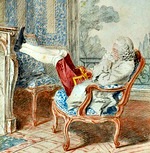
La nuit, la neige- Messages : 18135
Date d'inscription : 21/12/2013
 Re: Meubles peints du XVIIIe siècle
Re: Meubles peints du XVIIIe siècle
La nuit, la neige a écrit:
Parmi ces meubles, les deux premiers sont identifiables dans la vente du banquier de la Cour, Nicolas Beaujon, en 1787 : le catalogue de la vente nous apprend également que l’illustre amateur « en avait ordonné la distribution et le goût » et que le peintre chargé de la décoration était Jean-Louis Prévost « le Jeune » (1740-1810).
Voilà qui me fait découvrir que Nicolas Beaujon n'était pas seulement le richissime collectionneur de moult merveilles ( dont un essaim de jolies femmes ) .
Facile ! car tout s'achète, n'est-ce pas ! Mais non, Beaujon était un véritable esthète, doté d'une âme d'artiste !
Ces petits meubles dont il « avait ordonné la distribution et le goût » (
 ) ne sont qu'absolument délicieux !!!
) ne sont qu'absolument délicieux !!! Je les adore .....



_________________
... demain est un autre jour .
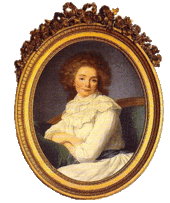
Mme de Sabran- Messages : 55508
Date d'inscription : 21/12/2013
Localisation : l'Ouest sauvage
 Re: Meubles peints du XVIIIe siècle
Re: Meubles peints du XVIIIe siècle
Beaujon, c'est pas ce gros poupard au milieu de ses berceuses ? 

_________________


Comtesse Diane- Messages : 7397
Date d'inscription : 21/12/2013
Localisation : TOURAINE

Lucius- Messages : 11656
Date d'inscription : 21/12/2013
Age : 33
 Re: Meubles peints du XVIIIe siècle
Re: Meubles peints du XVIIIe siècle
Ces bijoux de petits meubles ornaient donc sans doute quelque salon ou boudoir du palais de l'Elysée . 
_________________
... demain est un autre jour .

Mme de Sabran- Messages : 55508
Date d'inscription : 21/12/2013
Localisation : l'Ouest sauvage
 Le mobilier peint de style néo-classique pompéien
Le mobilier peint de style néo-classique pompéien
Prochainement présenté en vente aux enchères...
A Louis XVI ormolu-mounted satinwood, amaranth and polychrome-painted secrétaire à abattant
By Adam Weisweiler, circa 1787-90
The rectangular grey-veined white marble top with pierced three-quarter gallery, inset with glazed polychrome-painted panels decorated with arabesques and cameos after the Antique, the panelled fall-front decorated with two Sèvres biscuit plaques, the reverse covered in green gilt-tooled leather, the interior with ebony stringing with four mahogany-lined drawers and pigeon-holes, with frieze drawer, the sides mounted with Sèvres biscuit plaques, on slightly spreading turned fluted legs joined by a concave-fronted rectangular undertier covered in grey-veined white marble, on toupie feet, the backboard stamped twice 'A. WEISWEILER'
503/4 in. (129 cm.) high, 31 in. (78.5 cm.) wide, 16 1/3 in. (41.5 cm.) deep
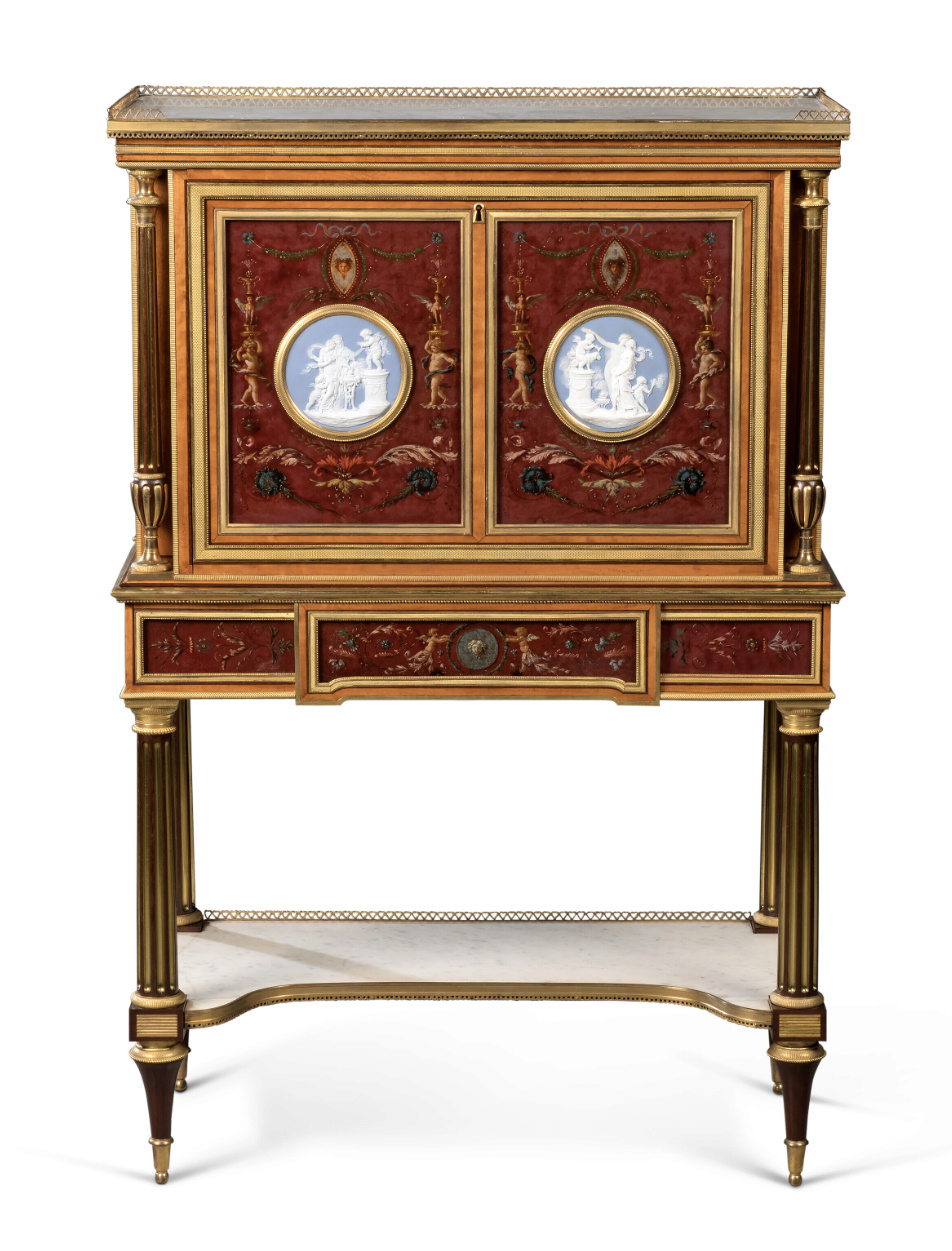

Lot Essay
Recalling the splendours of the classical interiors of Ancient Rome, this jewel-like secretaire delicately painted with grotesques, inset with striking biscuit medallions and framed by delicately-tooled ormolu borders, belongs to a luxurious group of polychrome-painted furniture by Adam Weisweiler made for the sumptuous and intimate neoclassical cabinets installed in the choicest Royal and noble residences of the late 1780s.
The rare and unusual painted arabesque decoration on paper surrounding biscuit plaques is particular to a small and prestigious corpus of furniture dating to the late 1780s in the most sophisticated and avant-garde taste. Inspired by exciting discoveries at Pompeii and Herculaneum in the 18th century, this striking new style was an interpretation of the vividly preserved wall paintings found in the remains of the the ancient villas.

A very closely related secretaire stamped Weisweiler (maître 26 March 1778), formerly in the collection of the Archduke Maximilian of Austria (1895–1952) at Castel Miramare, Trieste, and now preserved in the Hofmobiliendepot, Vienna, has identical Sèvres biscuit medallions and painted decoration by the same hand as the present secretaire, with some very minor variations to the design and on a light green as opposed to a red ground. The Vienna secretaire, given to Maximilian’s wife Charlotte of Belgium by Napoleon III, is also of the same form as the present lot, although it is more richly mounted.
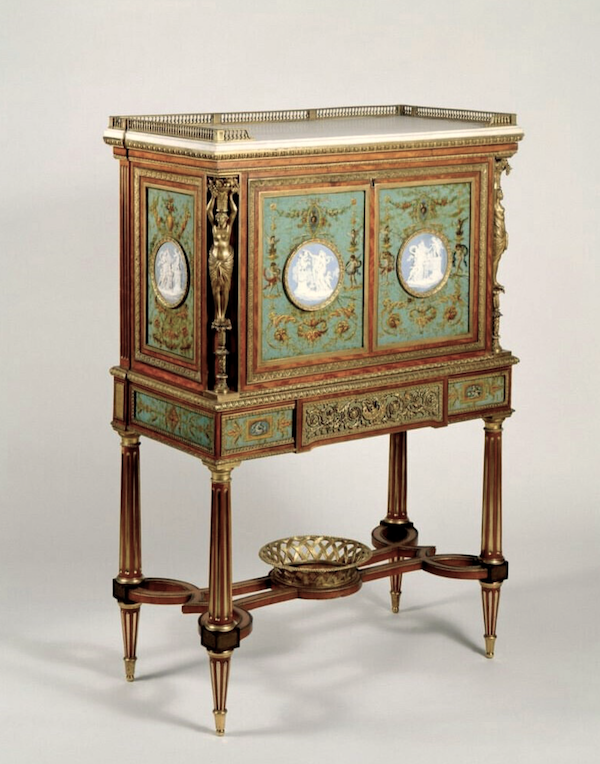
A bureau plat stamped Weisweiler formerly in the collection of Alfred de Rothschild (sold Sotheby’s, Monaco, 4 December 1992, lot 7) has a similar gallery to the Vienna secretaire and closely related polychrome-painted decoration on a light green ground and was possibly made en suite.

The Sèvres biscuit plaques on these secretaires as well as the painted decoration also relate closely to the great jewel cabinet by Ferdinand Schwerdfeger supplied to Marie Antoinette in 1787 for the chambre de la reine at the château de Versailles (OA 5515). Designed by Jean-Demosthene Dugourc and with identical Sèvres plaques to the present lot and related painted arabesque panels by Jacques-Joseph Degault, the jewel cabinet completes the corpus and is indicative of the type of distinction and status the patron of the secretaire most certainly possessed.

Image : Château de Versailles, Dist. RMN / Christophe Fouin
The use of Sèvres jasperware medallions in imitation of Wedgwood and painted decoration on a cabinet by Weisweiler inevitably recalls the work of the marchand-mercier Dominique Daguerre who pioneered this decorative scheme and from 1787 was Wedgwood’s representative in Paris. The subjects depicted on the medallions, made by Sèvres after the Wedgwood design, appear on pieces in the Louis XVI Sèvres service and on the Sèvres Factory registers between 1775 and 1783 and are entitled offrande à l'Hymen and offrande à l'amour (see G. de Bellaigue, The Louis XVI Service, London, 1986, pp. 244-245).
Indeed the 1788 French edition of Wedgwood's catalogues includes plaques of the same subject of 4in. (10cm.) diameter entitled sacrifice à l'Amour no. 169, and sacrifice à l'Hymen no. 170. The limited variety of designs for these plaques explains why each is repeated twice.


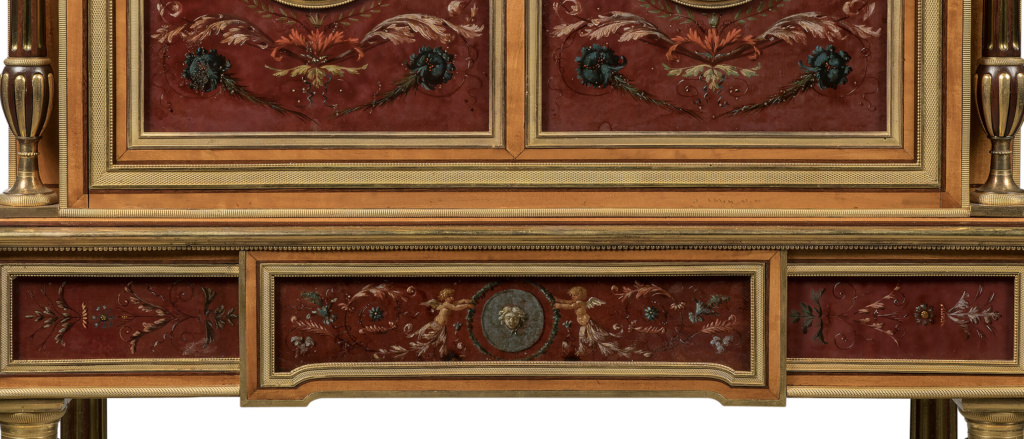
As well as the Pompeiian decorative scheme employed, the form of the secretaire is also conceived in the ‘antique’ fashion and is identical, with its fluted columns on fluted bulbous supports, tooled ormolu frame, frieze drawer with shaped central panel, fluted columnar legs, and shaped marble stretcher to two lacquer secretaires stamped by Weisweiler and supplied in the late 18th century by Dominique Daguerre to the 2nd Earl Spencer, currently preserved at Althorp House, Northamptonshire, as well as a further lacquer secretaire attributed to Weisweiler, formerly in a Rothschild collection and sold Christie’s London, 2 November 1997, lot 93.

Bureau from Alfred de Rothschild collection
The ‘grotesque’ decoration in the Pompeiian manner seen on the secretaire and the related pieces almost certainly derives from the decorative schemes for boudoirs Turcs introduced for the comte d’Artois from the late 1770s. A painted door panel from the 1781 boudoir Turc of the comte d’Artois at the château de Versailles, currently preserved in the Metropolitan Museum of Art (inv. No. 07.225.458b) and illustrated here, presents a very closely related decorative scheme to that on the secretaire. With a jasperware oval medallion in an imitation ormolu border and arabesque motifs hung with floral swags and interspersed with figures, this design by the frères Rousseau displays clear similarities to the decoration of the secretaire. While the door panel’s decoration is ‘à la turque’, as evidenced by the turbaned figures, the secretaire’s decoration is, in accordance with its later date, ‘à l’antique’ and this represents clearly the evolution in style in the five or so years between the creation of the panel and the execution of the secretaire.


Door panels from the "Cabinet Turc" of Comte d'Artois at Versailles (1781)
Image : Metropolitan Museum of Arts
The frères Rousseau, as Jean -Siméon Rousseau de la Rottière (1747–1820) and Jules-Hugues Rousseau (1743–1806) were known, executed other elaborate decorative schemes in the Pompeiian style similar to that on the secretaire, including Marie Antoinette’s boudoir d’argent, executed at the chateau de Fontainebleau circa 1785-86.


Images : Forum de Marie-Antoinette
Another candidate for the design of the secretaire could be Dominique Dugourc and François-Joseph Bélanger (1744-1818) who worked on the design and decoration of the château de Bagatelle for the comte d'Artois in 1777. In 1789 Bélanger was commissioned by the courtesan Anne-Marie Dervieux to extend and improve her hôtel particulier on the rue Chantereine in the Etruscan manner. While the doors of her dining room were decorated with arabesques and allegorical vignettes in the manner of Dugourc, the bathroom, illustrated here in a 1790 watercolour by Detournelle, was painted in a similar decorative scheme to the present lot, with figures and cameos à l’antique on a Wedgwood blue ground.

Salle de bains et boudoir de la maison de Mlle Dervieux, vers 1792-179
Armand-Parfait Prieur d’après François-Joseph Bélanger
Eau-forte et aquarelle
Image: Musée Carnavalet, Histoire de Paris
A link to the present lot is tantalisingly suggested by the record in Madame Dervieux’s hôtel of two ‘secrétaires de bois des Iles peints en ornements’, a description which would fit the present lot.
One of Bélanger’s other clients, the trésorier général of the Navy, Baldart de Saint James, owned in 1787 ‘un secrétaire de femme en bois peint et verni arabesque garni en bronze doré, balustres ouvert et ride, 360 livres’. This description is also tantalisingly close to that of our own secretaire and suggests at the very least that Bélanger was involved in the design and production of secretaires decorated in the neoclassical Pompeiian manner. Interestingly, Bélanger would go on to marry his former client Madame Dervieux in 1791.
* Source et infos complémentaires : Christie's - Londres, vente du 6 juillet 2023
A Louis XVI ormolu-mounted satinwood, amaranth and polychrome-painted secrétaire à abattant
By Adam Weisweiler, circa 1787-90
The rectangular grey-veined white marble top with pierced three-quarter gallery, inset with glazed polychrome-painted panels decorated with arabesques and cameos after the Antique, the panelled fall-front decorated with two Sèvres biscuit plaques, the reverse covered in green gilt-tooled leather, the interior with ebony stringing with four mahogany-lined drawers and pigeon-holes, with frieze drawer, the sides mounted with Sèvres biscuit plaques, on slightly spreading turned fluted legs joined by a concave-fronted rectangular undertier covered in grey-veined white marble, on toupie feet, the backboard stamped twice 'A. WEISWEILER'
503/4 in. (129 cm.) high, 31 in. (78.5 cm.) wide, 16 1/3 in. (41.5 cm.) deep


Lot Essay
Recalling the splendours of the classical interiors of Ancient Rome, this jewel-like secretaire delicately painted with grotesques, inset with striking biscuit medallions and framed by delicately-tooled ormolu borders, belongs to a luxurious group of polychrome-painted furniture by Adam Weisweiler made for the sumptuous and intimate neoclassical cabinets installed in the choicest Royal and noble residences of the late 1780s.
The rare and unusual painted arabesque decoration on paper surrounding biscuit plaques is particular to a small and prestigious corpus of furniture dating to the late 1780s in the most sophisticated and avant-garde taste. Inspired by exciting discoveries at Pompeii and Herculaneum in the 18th century, this striking new style was an interpretation of the vividly preserved wall paintings found in the remains of the the ancient villas.

A very closely related secretaire stamped Weisweiler (maître 26 March 1778), formerly in the collection of the Archduke Maximilian of Austria (1895–1952) at Castel Miramare, Trieste, and now preserved in the Hofmobiliendepot, Vienna, has identical Sèvres biscuit medallions and painted decoration by the same hand as the present secretaire, with some very minor variations to the design and on a light green as opposed to a red ground. The Vienna secretaire, given to Maximilian’s wife Charlotte of Belgium by Napoleon III, is also of the same form as the present lot, although it is more richly mounted.

A bureau plat stamped Weisweiler formerly in the collection of Alfred de Rothschild (sold Sotheby’s, Monaco, 4 December 1992, lot 7) has a similar gallery to the Vienna secretaire and closely related polychrome-painted decoration on a light green ground and was possibly made en suite.

The Sèvres biscuit plaques on these secretaires as well as the painted decoration also relate closely to the great jewel cabinet by Ferdinand Schwerdfeger supplied to Marie Antoinette in 1787 for the chambre de la reine at the château de Versailles (OA 5515). Designed by Jean-Demosthene Dugourc and with identical Sèvres plaques to the present lot and related painted arabesque panels by Jacques-Joseph Degault, the jewel cabinet completes the corpus and is indicative of the type of distinction and status the patron of the secretaire most certainly possessed.

Image : Château de Versailles, Dist. RMN / Christophe Fouin
The use of Sèvres jasperware medallions in imitation of Wedgwood and painted decoration on a cabinet by Weisweiler inevitably recalls the work of the marchand-mercier Dominique Daguerre who pioneered this decorative scheme and from 1787 was Wedgwood’s representative in Paris. The subjects depicted on the medallions, made by Sèvres after the Wedgwood design, appear on pieces in the Louis XVI Sèvres service and on the Sèvres Factory registers between 1775 and 1783 and are entitled offrande à l'Hymen and offrande à l'amour (see G. de Bellaigue, The Louis XVI Service, London, 1986, pp. 244-245).
Indeed the 1788 French edition of Wedgwood's catalogues includes plaques of the same subject of 4in. (10cm.) diameter entitled sacrifice à l'Amour no. 169, and sacrifice à l'Hymen no. 170. The limited variety of designs for these plaques explains why each is repeated twice.



As well as the Pompeiian decorative scheme employed, the form of the secretaire is also conceived in the ‘antique’ fashion and is identical, with its fluted columns on fluted bulbous supports, tooled ormolu frame, frieze drawer with shaped central panel, fluted columnar legs, and shaped marble stretcher to two lacquer secretaires stamped by Weisweiler and supplied in the late 18th century by Dominique Daguerre to the 2nd Earl Spencer, currently preserved at Althorp House, Northamptonshire, as well as a further lacquer secretaire attributed to Weisweiler, formerly in a Rothschild collection and sold Christie’s London, 2 November 1997, lot 93.

Bureau from Alfred de Rothschild collection
The ‘grotesque’ decoration in the Pompeiian manner seen on the secretaire and the related pieces almost certainly derives from the decorative schemes for boudoirs Turcs introduced for the comte d’Artois from the late 1770s. A painted door panel from the 1781 boudoir Turc of the comte d’Artois at the château de Versailles, currently preserved in the Metropolitan Museum of Art (inv. No. 07.225.458b) and illustrated here, presents a very closely related decorative scheme to that on the secretaire. With a jasperware oval medallion in an imitation ormolu border and arabesque motifs hung with floral swags and interspersed with figures, this design by the frères Rousseau displays clear similarities to the decoration of the secretaire. While the door panel’s decoration is ‘à la turque’, as evidenced by the turbaned figures, the secretaire’s decoration is, in accordance with its later date, ‘à l’antique’ and this represents clearly the evolution in style in the five or so years between the creation of the panel and the execution of the secretaire.


Door panels from the "Cabinet Turc" of Comte d'Artois at Versailles (1781)
Image : Metropolitan Museum of Arts
The frères Rousseau, as Jean -Siméon Rousseau de la Rottière (1747–1820) and Jules-Hugues Rousseau (1743–1806) were known, executed other elaborate decorative schemes in the Pompeiian style similar to that on the secretaire, including Marie Antoinette’s boudoir d’argent, executed at the chateau de Fontainebleau circa 1785-86.


Images : Forum de Marie-Antoinette
Another candidate for the design of the secretaire could be Dominique Dugourc and François-Joseph Bélanger (1744-1818) who worked on the design and decoration of the château de Bagatelle for the comte d'Artois in 1777. In 1789 Bélanger was commissioned by the courtesan Anne-Marie Dervieux to extend and improve her hôtel particulier on the rue Chantereine in the Etruscan manner. While the doors of her dining room were decorated with arabesques and allegorical vignettes in the manner of Dugourc, the bathroom, illustrated here in a 1790 watercolour by Detournelle, was painted in a similar decorative scheme to the present lot, with figures and cameos à l’antique on a Wedgwood blue ground.

Salle de bains et boudoir de la maison de Mlle Dervieux, vers 1792-179
Armand-Parfait Prieur d’après François-Joseph Bélanger
Eau-forte et aquarelle
Image: Musée Carnavalet, Histoire de Paris
A link to the present lot is tantalisingly suggested by the record in Madame Dervieux’s hôtel of two ‘secrétaires de bois des Iles peints en ornements’, a description which would fit the present lot.
One of Bélanger’s other clients, the trésorier général of the Navy, Baldart de Saint James, owned in 1787 ‘un secrétaire de femme en bois peint et verni arabesque garni en bronze doré, balustres ouvert et ride, 360 livres’. This description is also tantalisingly close to that of our own secretaire and suggests at the very least that Bélanger was involved in the design and production of secretaires decorated in the neoclassical Pompeiian manner. Interestingly, Bélanger would go on to marry his former client Madame Dervieux in 1791.
* Source et infos complémentaires : Christie's - Londres, vente du 6 juillet 2023

La nuit, la neige- Messages : 18135
Date d'inscription : 21/12/2013
 Le mobilier peint de style néo-classique pompéien
Le mobilier peint de style néo-classique pompéien
Beaucoup (trop ?  ) de thèmes abordés dans cette note de présentation, que vous retrouverez également dans nos différentes rubriques, dont :
) de thèmes abordés dans cette note de présentation, que vous retrouverez également dans nos différentes rubriques, dont :
 Le secrétaire de Weisweiler offert par Napoléon III à Charlotte de Belgique, épouse de l'archiduc Maximilien d'Autriche (futur empereur du Mexique), aujourd'hui conservé au Musée du mobilier impérial autrichien (Hofmobiliendepot), à Vienne, et parfois décrit comme un meuble ayant appartenu à Marie-Antoinette est longuement décrit dans notre sujet :
Le secrétaire de Weisweiler offert par Napoléon III à Charlotte de Belgique, épouse de l'archiduc Maximilien d'Autriche (futur empereur du Mexique), aujourd'hui conservé au Musée du mobilier impérial autrichien (Hofmobiliendepot), à Vienne, et parfois décrit comme un meuble ayant appartenu à Marie-Antoinette est longuement décrit dans notre sujet :
 Un secrétaire Weisweiler de Marie-Antoinette à Vienne ?
Un secrétaire Weisweiler de Marie-Antoinette à Vienne ?
A noter qu'ici, sur ce meuble aux finitions bien plus luxueuses, les peintures à la gouache sont protégées par des plaques de verre.



Images : Forum de Marie-Antoinette
 De même, et concernant le lien avec le serre-bijoux de Marie-Antoinette conservé à Versailles, rappelons que s'il est bien agrémenté de médaillons de porcelaine de Sèvres, les plaques décoratives dans le goût pompéien sont quant à elles peintes sous verre.
De même, et concernant le lien avec le serre-bijoux de Marie-Antoinette conservé à Versailles, rappelons que s'il est bien agrémenté de médaillons de porcelaine de Sèvres, les plaques décoratives dans le goût pompéien sont quant à elles peintes sous verre.

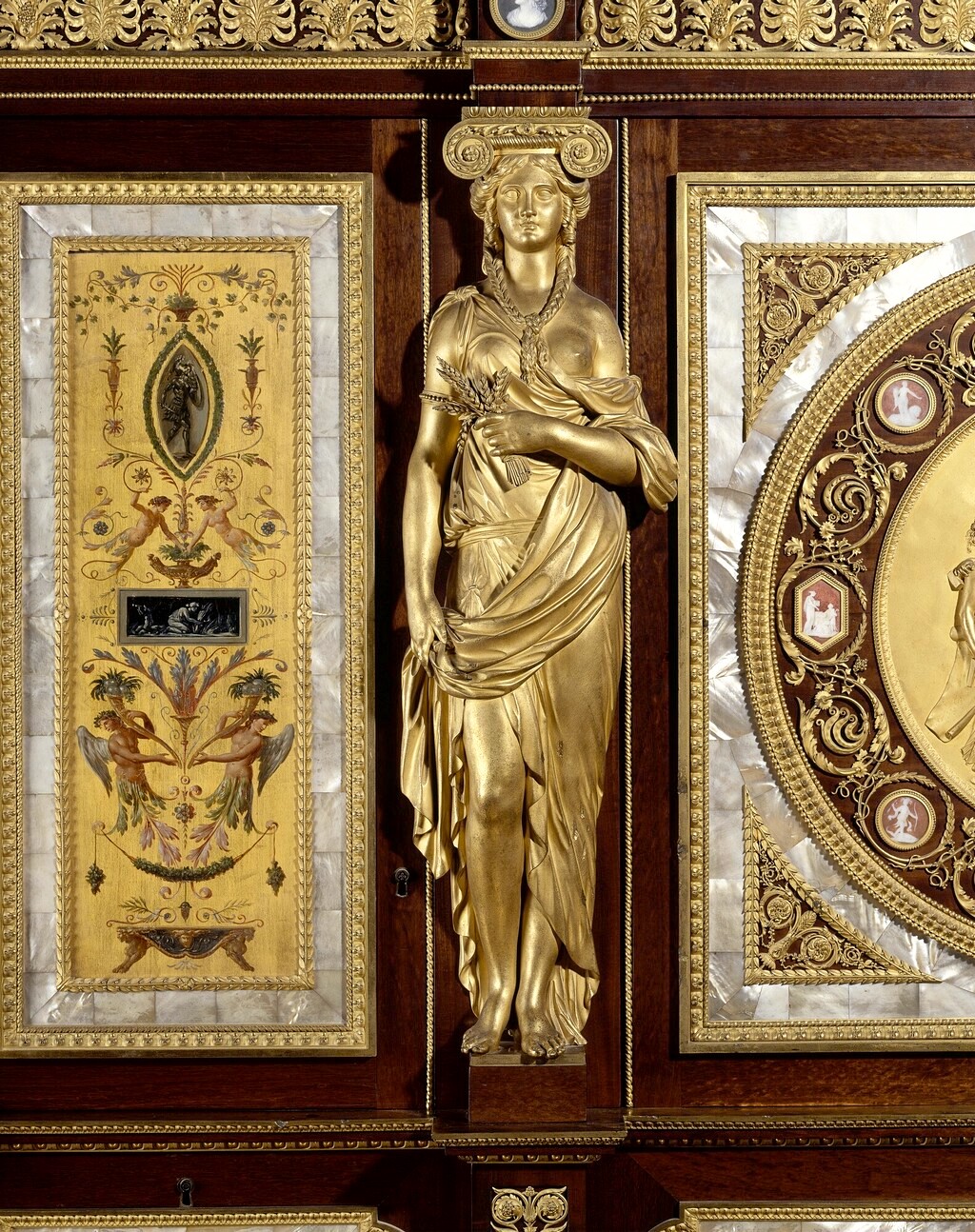
Images : Château de Versailles, Dist. RMN-Grand Palais / Christophe Fouin
Voir nos sujets :
 La corbeille de mariage et le serre-bijoux de Marie-Antoinette à Versailles
La corbeille de mariage et le serre-bijoux de Marie-Antoinette à Versailles
 La peinture sous ou sur verre au XVIIIe siècle et la technique du verre églomisé
La peinture sous ou sur verre au XVIIIe siècle et la technique du verre églomisé
 Je recommande également la lecture de notre sujet consacré au meubles décorés de porcelaine Wedgwood (et non pas de Sèvres) dans lequel vous retrouverez d'autres création d'Adam Weisweiler, comme par exemple :
Je recommande également la lecture de notre sujet consacré au meubles décorés de porcelaine Wedgwood (et non pas de Sèvres) dans lequel vous retrouverez d'autres création d'Adam Weisweiler, comme par exemple :

Secrétaire à abattant en cabinet en placage de loupe d'if et acajou, plaques de biscuit de Wedgwood à encadrement de tôle laquée à motifs néoclassiques et arabesques
Estampillé A. Weisweiler
Image : Sotheby's
 Le mobilier décoré de porcelaines Wedgwood : l'influence et le goût du marchand-mercier Dominique Daguerre
Le mobilier décoré de porcelaines Wedgwood : l'influence et le goût du marchand-mercier Dominique Daguerre
 Concernant la ligne de ce secrétaire à abattant, décrite comme "à l'antique", rappelons qu'elle fut reproduite par Weisweiler avec d'autres matériaux, comme par exemple cette paire de secrétaires, cette fois-ci décorés de panneaux de laque du Japon et vernis parisien :
Concernant la ligne de ce secrétaire à abattant, décrite comme "à l'antique", rappelons qu'elle fut reproduite par Weisweiler avec d'autres matériaux, comme par exemple cette paire de secrétaires, cette fois-ci décorés de panneaux de laque du Japon et vernis parisien :


Secrétaires en cabinet
Attribués à Adam Weisweiler et son atelier
Laque du Japon, vernis parisien, placage d'ébène et bronze doré de la fin de l’époque Louis XVI (l'un vers 1790, l'autre vers 1800)
Image : Sotheby's
 Sont également évoqués dans le descriptif de la maison de vente :
Sont également évoqués dans le descriptif de la maison de vente :
 Les décors et meubles des boudoirs turcs du comte d'Artois
Les décors et meubles des boudoirs turcs du comte d'Artois
 Le Boudoir d'Argent de Marie-Antoinette au château de Fontainebleau
Le Boudoir d'Argent de Marie-Antoinette au château de Fontainebleau
 Quant à Anne-Victoire Dervieux, danseuse et chanteuse d'opéra, célèbre courtisane, propriétaire d'un superbe hôtel particulier, rue Chantereine à Paris, réaménagé par l'architecte François-Joseph Bélanger (qu'elle finira par épouser), nous en parlons ici :
Quant à Anne-Victoire Dervieux, danseuse et chanteuse d'opéra, célèbre courtisane, propriétaire d'un superbe hôtel particulier, rue Chantereine à Paris, réaménagé par l'architecte François-Joseph Bélanger (qu'elle finira par épouser), nous en parlons ici :

Hôtel de Mademoiselle Dervieux
Anonyme, 18e siècle
Dessin aquarelle
Image : Musée Carnavalet, Histoire de Paris
 Mademoiselle Anne-Victoire Dervieux
Mademoiselle Anne-Victoire Dervieux
 ) de thèmes abordés dans cette note de présentation, que vous retrouverez également dans nos différentes rubriques, dont :
) de thèmes abordés dans cette note de présentation, que vous retrouverez également dans nos différentes rubriques, dont : A noter qu'ici, sur ce meuble aux finitions bien plus luxueuses, les peintures à la gouache sont protégées par des plaques de verre.



Images : Forum de Marie-Antoinette


Images : Château de Versailles, Dist. RMN-Grand Palais / Christophe Fouin
Voir nos sujets :

Secrétaire à abattant en cabinet en placage de loupe d'if et acajou, plaques de biscuit de Wedgwood à encadrement de tôle laquée à motifs néoclassiques et arabesques
Estampillé A. Weisweiler
Image : Sotheby's


Secrétaires en cabinet
Attribués à Adam Weisweiler et son atelier
Laque du Japon, vernis parisien, placage d'ébène et bronze doré de la fin de l’époque Louis XVI (l'un vers 1790, l'autre vers 1800)
Image : Sotheby's

Hôtel de Mademoiselle Dervieux
Anonyme, 18e siècle
Dessin aquarelle
Image : Musée Carnavalet, Histoire de Paris

La nuit, la neige- Messages : 18135
Date d'inscription : 21/12/2013
 Sujets similaires
Sujets similaires» Papiers peints de rêve au XVIIIe siècle
» Meubles à secrets au XVIIIe siècle et sous l‘Empire
» Meubles du XVIIIe siècle en acier et la manufacture de Tula (Russie)
» Les oeufs de Pâques et les oeufs d'Autruche peints au XVIIIe siècle
» À Versailles, désormais, on supprime du XVIIIe siècle pour retrouver du XVIIIe
» Meubles à secrets au XVIIIe siècle et sous l‘Empire
» Meubles du XVIIIe siècle en acier et la manufacture de Tula (Russie)
» Les oeufs de Pâques et les oeufs d'Autruche peints au XVIIIe siècle
» À Versailles, désormais, on supprime du XVIIIe siècle pour retrouver du XVIIIe
LE FORUM DE MARIE-ANTOINETTE :: La France et le Monde au XVIIIe siècle :: Les Arts et l'artisanat au XVIIIe siècle :: Le mobilier du XVIIIe siècle
Page 1 sur 1
Permission de ce forum:
Vous ne pouvez pas répondre aux sujets dans ce forum